Guy Bleus: Exploring mail-art
Bleus, Guy: Exploring Mail-Art, in: Commonpress No. 56. Commonpress Retrospective, Administration Center, Wellen, Belgium - Museum het Toreke, Tienen, Belgium, September, 1984, pp. 10–65. (Ed. by Guy Bleus)
Although thousands of artists “practice” Mail-Art there have been only a few attempts to come to a better comprehension of the whole realm of Mail-Art. There is a need for theory and intelligibility.
From my experience as a mail-artist, this text is a suggestion to start with a rational analysis of Mail-Art in order to come to a coherent socio-cultural theory and a clear synthesis of the “total” phenomenon. I think that inquiries (especially those, made by mail-artists) into the nature and about the different aspects of Mail-Art will give a clearer view upon the communication and the misunderstanding and will only benefit the efficient working of the planetary Network.
This text is meant for everyone interested in Mail-Art, but especially for mail-artists. Some points are very contestable. But Mail-Art demands for an echo. So all kinds of response and feedback are very welcome. Ideas procreate new ideas, new and better (more rational) insights in concepts and activities. Friedrich Nietzsche said that understanding stops action. Yet, the “survival” of Mail-Art is dependent on the “common” thoughts of mail-artists about Mail-Art.
The Word: “Mail-Art”
1. Etymology
From a philosophical, idealistic angle there has been proposed that a thing only “really” exists, when it has a name (concept). Nevertheless, we must admit that there has been Mail-Art activities “avant-la-lettre.”
The first term to indicate these activities were e.g. “flux-post”, “mailings” and “correspondence (art)”. The term “Mail-Art” has presumably been used for the first time in the early seventies. But it is historical hard to say “exactly” who, where and when.
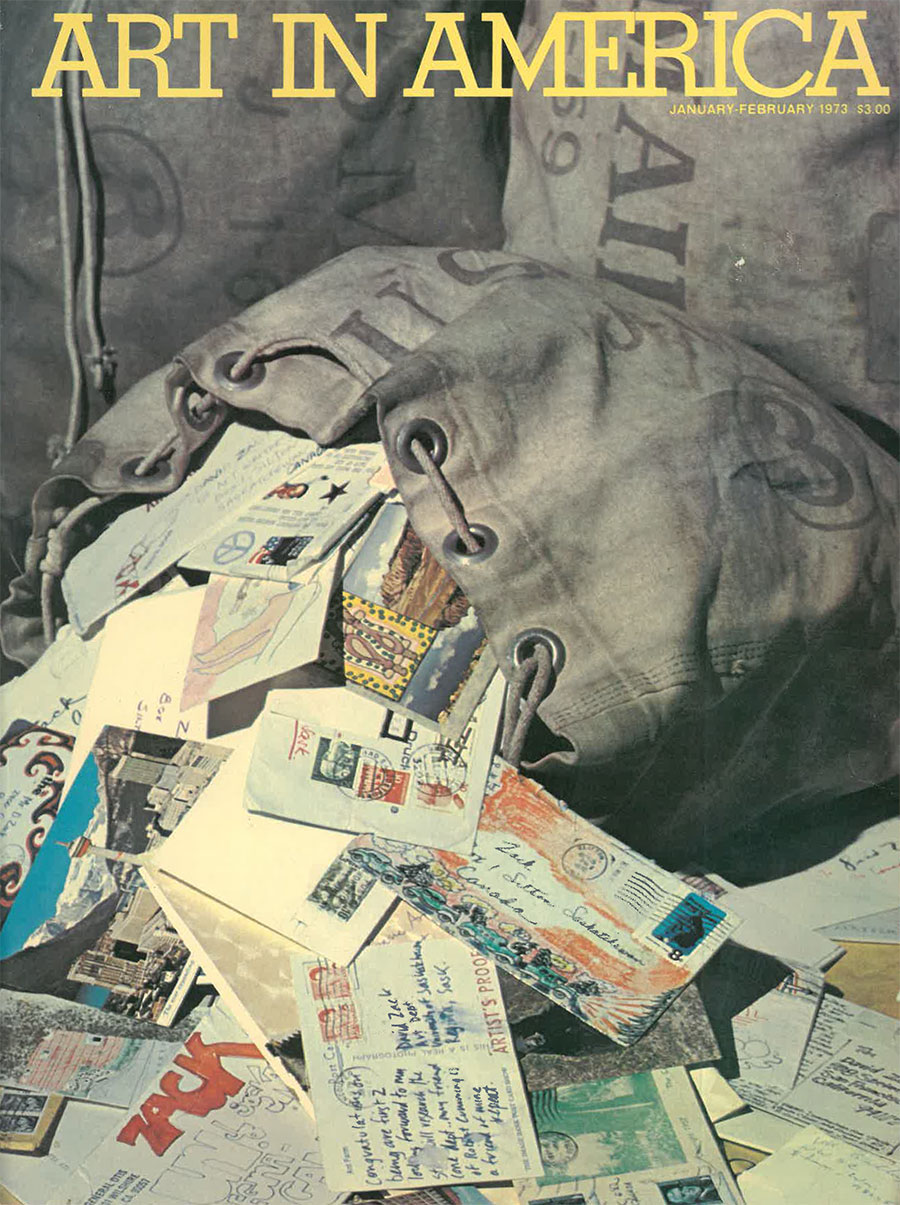
Cover of Art in America Vol. 61, No. 1. A pioneering article (An Authentik and Historikal Discourse on the Phenomenon of Mail Art) of David Zack was published in this issue.
2. Grammar
The word “Mail-Art” is a class-name (not a proper name). It is used in different ways:
- concrete: 1) as a noun (substantive): e.g. in: “Mail-Art is an art-forum”, “rubber-stamps used in Mail-Art”, “the Mail-Art of John Evans”. 2) as a nounin the function of a direct object: e.g. in: “to do Mail-Art”, “doing Mail-Art”, “to make Mail-Art”, “making Mail-Art”.
- abstract: as an adjective (attribute): e.g. in: “a Mail-Art show” or “a Mail-Art message”, “Mail-Art languages”.
3. Spelling
The phonetic spelling of Mail-Art is “MEIL a:t”. The stressed syllable is here written in capital letters. The way of writing the word “Mail-Art” is not always the same. E.g. with or without capital and hyphen. The next seven ways of writing are mostly used: a) Mail(-)Art; b) Mail(-)art; c) mail(-)art and d) mailart.
Anyway, the term “Mail-Art” is preferred instead of its (approximately) synonyms “post art”, “postal art”, “art mail” or “correspondence art”. Sometimes we meet the terms “arte postale” (It.), “Post-Kunst” (Germ., Dutch), “art postal” (Fr.), “arte correo” (Sp.), etc. Otherwhere the word “Mail-Art” is written as its homonym “Male-Art” as a kind of joke, just as “Fe-Mail Art”.
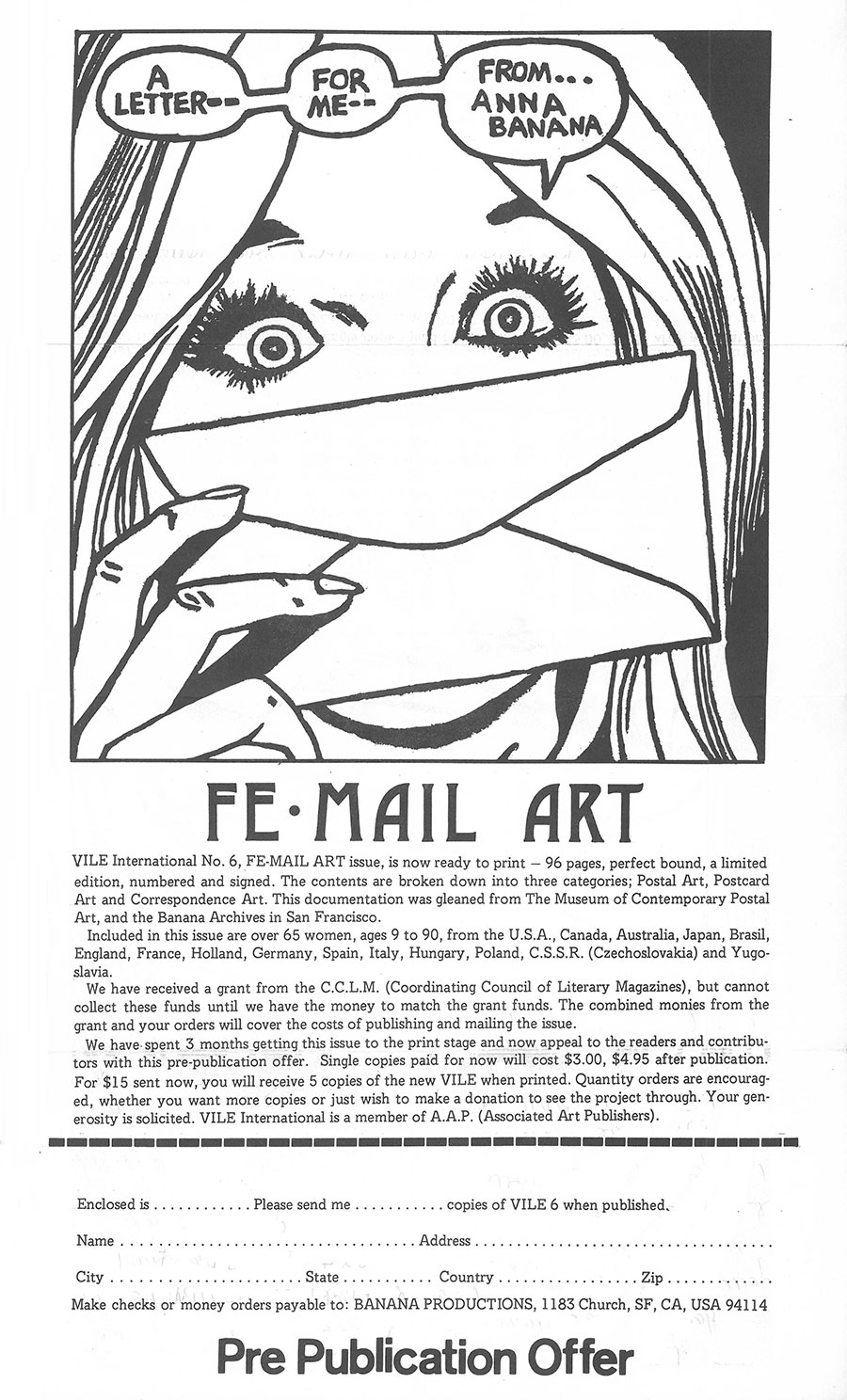
Preorder form for the VILE International No. 6, Fe-Mail Art issue edited by Anna Banana and Bill Gaglione.
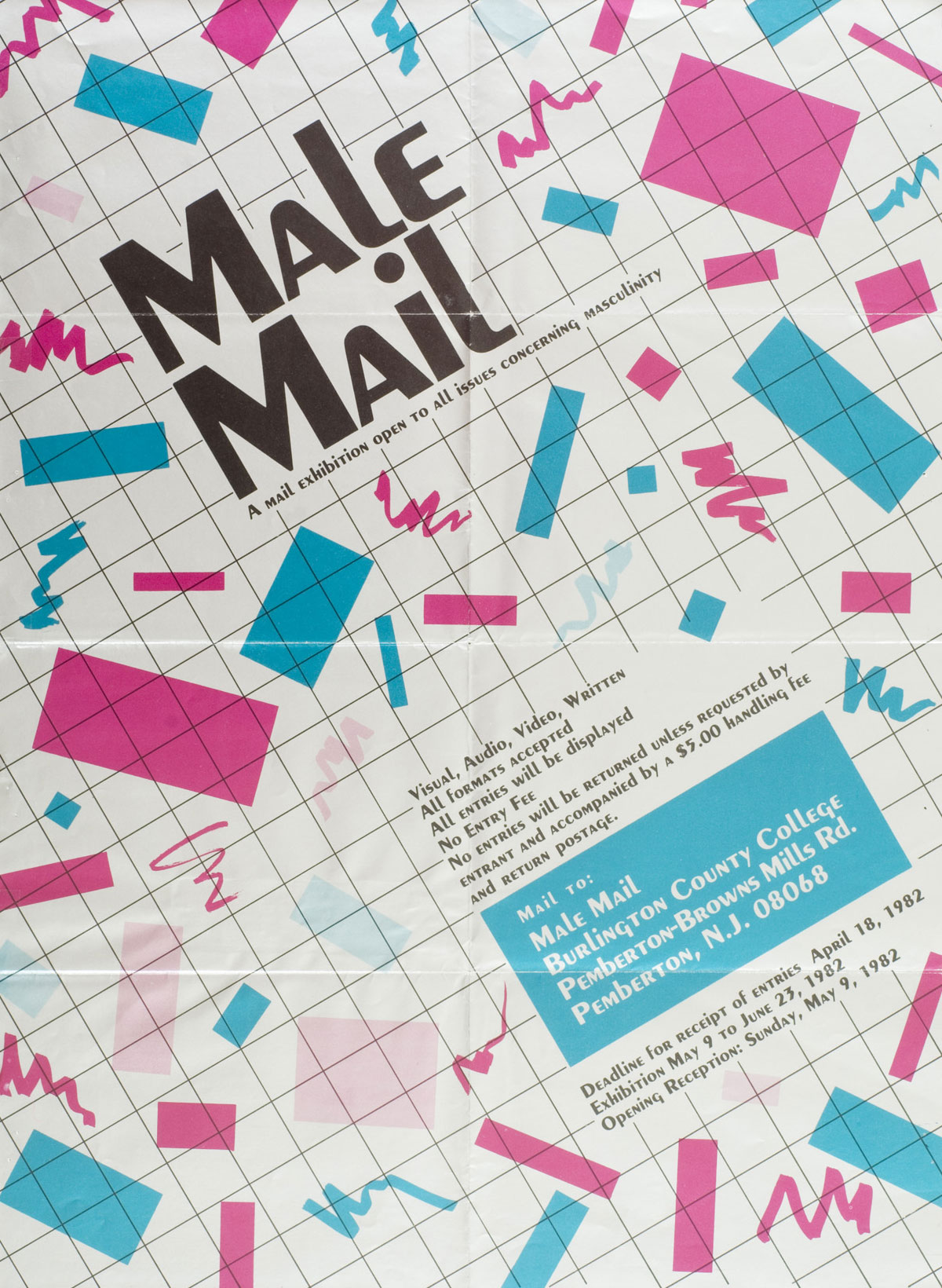
Poster calling for entries for the Male Mail exhibition organized in 1982.
4. Meanings
It is a complex matter to define the word “Mail-Art”, because it is used with more than one meaning. When we ask about the meaning of Mail-Art, we can ask about a) the meaning of the word and b) the meaning of the thing (already knowing the meaning of the word, asking about its purpose).
To define the word “Mail-Art” we can employ different ways:
- definition by equivalent words: sometimes the term “Mail-Art” is used equivalent with “correspondence art”; but some people make a distinction between both, saying that “correspondence art” is a way of personal and direct communication, while “Mail-Art” is a way of unpersonal, undirectional, one-way communication. I think that this distinction is not relevant for recent Mail-Art, which includes the categories attached to “correspondence art.” Other equivalent words (but with probably a different connotation) are “post art”, “postal art”, “Art by mail” and “Art-mail”.
- Ostensive definition: making the meaning of “Mail-Art” clear, not by using words (verbal communication), but by e.g. showing someone Mail-Art (or pointing at, or confronting). E.g. when Lon Spiegelman says: “the only way to really know mailart is to live it”.
- Definition by connotation: referring to all the associations the “Mail-Art” has in the minds of the people who use it. The emotive (poetic, pictorial, …) meaning of the word.
- Definition by denotation: referring to “all” the objects (every individual thing) to which the word “Mail-Art” is applicable.
- With Ludwig Wittgenstein we can consider the word “Mail-Art” as a tool, performing some job in our communication: the meaning is the use.
The most remarkable used meanings of the word “Mail-Art” is:
- (Product) a work of Mail-Art (an object, a thing, a message, …): this can be for instance: a copy-art-work or a stamp-art-work that has been transmitted (mailed). E.g. in: “an example of Mail-Art”, “a piece of Mail-Art”, “good Mail-Art”, “Mail-Art is never juried”, “Mail-Art exhibition”.
- (Process) a process of creating Mail-Art (an activity): e.g. in: “to do Mail-Art”, “doing Mail-Art”.
- (Structure) an art movement based on exchange: a planetary network of thousands of artists and non-artists exchanging (art, communication, semiosis) with one another and using communication media as art media (post, telex, etc.). “A circuit, a web, a community, a system, …”, “perhaps the most important art movement in the world today” (C. Pittore).
- (Medium) multilateral art form based on exchange: a language using communication media as art media (post, telegraphy, …), “an instrument, a form, a way, a means of communication”. Mail-Art is a language (medium) using languages (media).
- (Concept) extension of the meaning of “mail” using the word “Mail-Art”: “Mail-Art used as “communication-art”, not necessarily related to the communication medium “post”, but extended to all other communication media (telegraphy, teletext, telex, computer networking, electronic mail, telephone, communication via radio, television, walkie talkie, balloons, etc.).
- (Concept) extension of the meaning of “art” using the word “Mail-Art”. E.g. in: Mail-Art is “a cultural strategy” (U. Carrión), “a complex activity that is not art after all” (V. Baroni), “a new cultural strategy”, “a democratic idea, that anyone can give and receive art” (Morgan), “a new artistic, cultural, social word” (CDO).
- (Mixing) Sometimes the word “Mail-Art” is used simultaneously with more than one meaning.
Conclusion: the word “Mail-Art” is not ambiguous by itself, but it is sometimes used ambiguously. Namely. when there is uncertainty about which meaning(s) is (are) used in the particular instance.
The Object: Mail-Art
5. Practice
Mail-Art is a “multilateral” art-form. It includes artists’books, audio- and video-art, periodicals, copy-art, assembling, artists’ postage stamps or artistamps, language-art, postcards, recycling-art, stamp-art, etc.… In my text “Mail-Art Initiation” (printed in the Mail-Art Atlas — 1982/83) one can find a summery of the most used techniques and materials in Mail-Art. The text does not pretend to be complete. The summery is not exhaustive. In principle we can say that, as long as a work can be transmitted or mailed (integral or in parts) all techniques, materials or methods can be used. And sometimes it is difficult to make a clear distinction between them.
Some techniques: collage, photography, decollage, assemblage, hand writing, graffiti, drawing, performance, typewriter, assembling, stamps, etc., etc. …
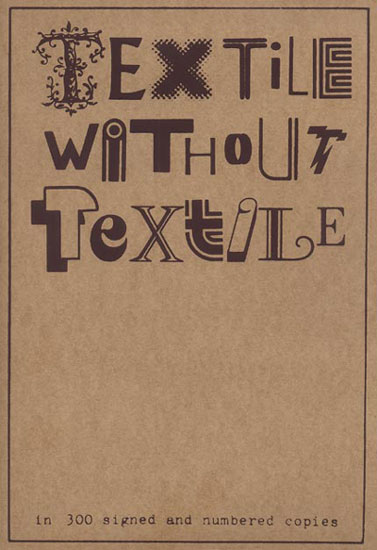
Textile Without Textile, the first Hungarian assembling publication was compiled by György Galántai in 1980
Some materials: (mostly not too heavy, for reasons of postal taxes): envelopes, aluminum, (handmade) paper, seals, stamps, wood, glass, plastic, scents, etc., etc. …
Some methods: direct communication, indirect communication, fictitious communication (no address mentioned on the sending), chain-letters, collective collages, assembling, etc.
6. History
There are already written enough short histories of Mail-Art to repeat it all again: Futurism, Dada, Nouveau Réalisme, Fluxus, Gutai, New York Correspondence School, etc. So I refer to the many articles on this subject in other Mail-Art catalogues and magazines. Yet, history is still waiting for a representative book about the “entire” Mail-Art Network. For one can doubt about the significance of a “local” history of Mail-Art. There is no specific history of Australian, Italian or American Mail-Art. Even historical, Mail-Art has to be considered as a “planetary” phenomenon, not as something “national” or “continental”.
7. Economy
The economic process of mail-art includes e.g. the production, distribution and consumption of material and immaterial mail-art goods in the world. Typical is that these three components (mostly) stay together in the hands of mail-artists. Mail-artists don’t distribute their art via official galleries, but by post. The distribution and production of Mail-Art can only become detached from one another in theory. E.g. a letter (message) that is not mailed (transmitted) is (usually) not considered as Mail-Art.
From an economic point of view the existence and working of Mail-Art returns to an ancient form of bartering. Mail-art is a primitive structure of direct and free art-bartering without our classic medium of art-exchange, the fetish “money”. In this respect we must agree “in principle” that the mail-artists or art-exchangers value the received higher than the exchanged. Otherwise they would not exchange! This is also due to the fact that they (mostly) value the “act of exchanging” (the communication) itself higher than the “objects or information of exchange”. So the “exchange-value” does not really matter. (But this is not an absolute assertion).
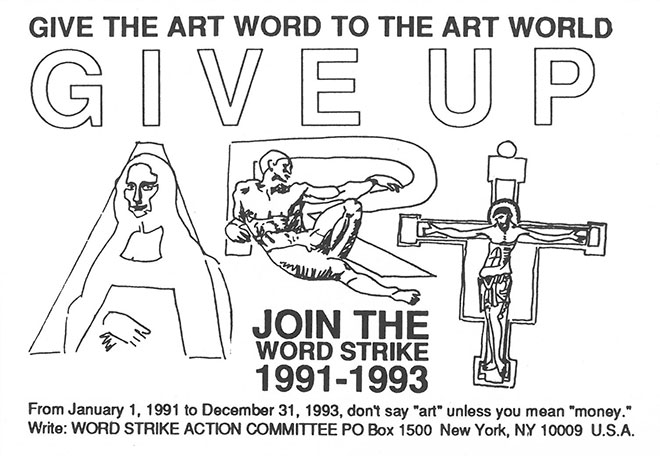 Postcard by Mark Bloch
Postcard by Mark Bloch
This economic aspect of Mail-Art can be indicated as “idealistic”. The exchange is based on mutual trust, confidence an belief. But the idealism is not forever. E.g. when artist X never answers the sending of Y, sooner or later the one-way communication or pseudo-exchange will stop. So, the “materialistic” aspect of receiving an answer (such as a personal letter or a catalogue) is especially important for its “psychological” (and practical) consequences: staying in communication.
For the production of Mail-Art a few conditions are necessary concerning time, energy (creativity) and money. Are Mail-Art activities expensive? The answer is an ambiguous one: yes and no. It depends. Yes: sending a postal package of 200 color copies (airmail, registered, express) from Belgium to the USA. No: sending an aerogramme from Japan to Brazil. But when a mail-artist would participate in “all” present projects, the conclusion is undoubtedly: it is “very” expensive. Nevertheless, in comparison with the other art-communication-media (telex, telephone, facsimile or telefax, …) the post-medium is a “relative” inexpensive way for art-communication. This economic aspect is of the reasons for the success of Mail-Art. So, let’s pray Hermes, the postman of the Gods, that the medium “post” will stay payable for every brother or sister-in-mail. The future of Mail-Art is closely (casually) related with this economic problem.
The consumption of Mail-Art consists especially in the participation of Mail-Art activities (prosumption). So it is, as already said, mostly related with the production and distribution. An exception for this correlation is the Mail-Art shows. Here, an (often) non-participating public is enjoying (consume) the “results” of the Mail-Art activities.
Some other economic problems are: selling and buying Mail-Art? Earning your living with Mail-Art? The relation of Mail-Art to the economic substructure? Its relation to the economic art-world (no relation?)? Has Mail-Art really an own (subsistence) art-economy? Etc.
Lastly, a non-idealistic and economic truth: the mail one gets from others is proportionate to the time and energy one has spent on one’s own sending.
8. Psychology
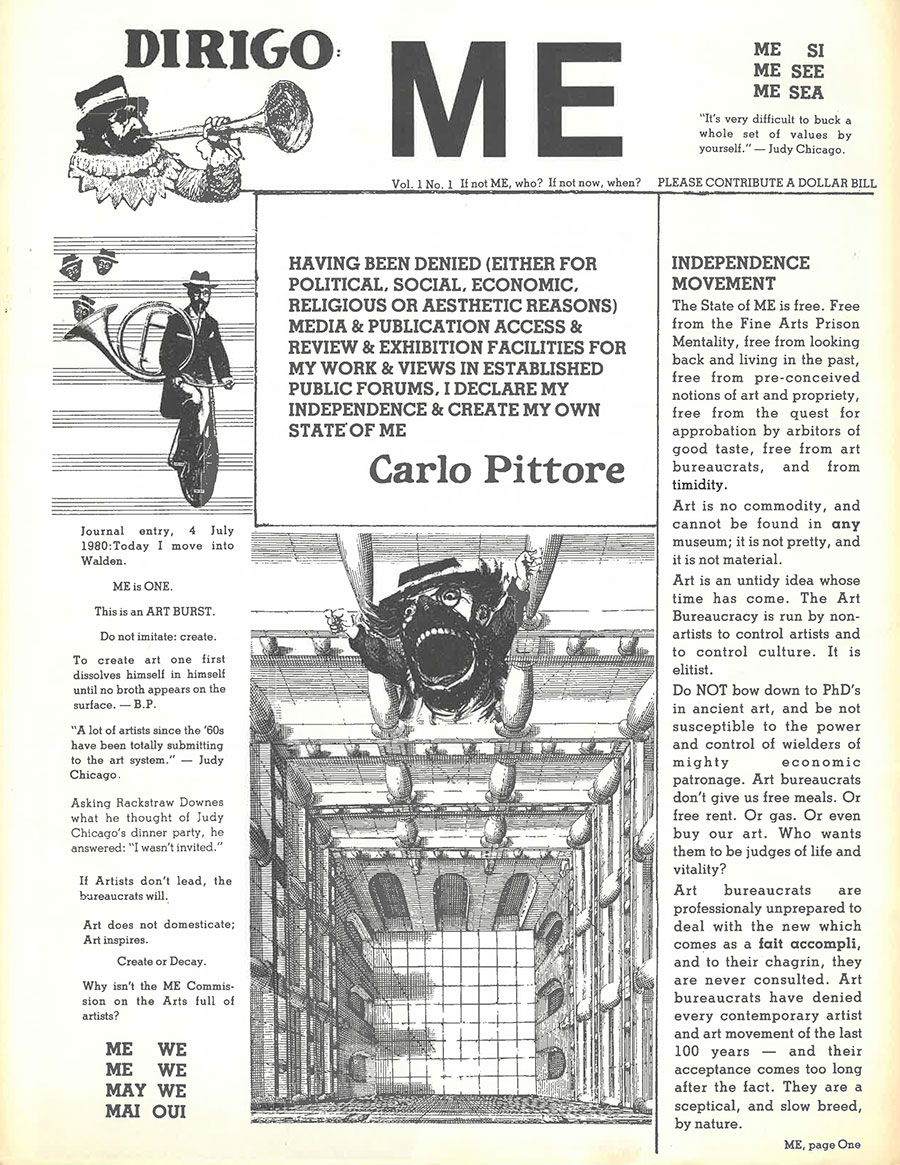
Cover of ME Vol. 1, No. 1, edited by Carlo Pittore in 1980.
One of the subjects of the psychology of Mail-Art is the study of the processes, motives, reactions and nature of the mind of mail-artists. Self-actualization, prestige, satisfaction of inner impulses, motivations, emotions, … It is hard to say what is the personal pressure behind the Mail-Art Whip. But for a better understanding of Mail-Art it is perhaps more interesting to stress some “social” psychological interactions.
A mail-artist is often a disappointed artist. Not disappointed in art, but in the art-industry of leading galleries and museums. Being a member of a planetary art movement helps him to transcend this isolation and alienation in art. In the Network the mail-artist is a part of a big art-community, but without losing his/her own identity and individuality. This unity of thousands of pARTners creates a feverish enthusiasm of cooperation and a protective feeling of solidarity on a basis of pluralism and tolerance. The triumph of Mail-Art results e.g. from the fact that there is a psychological equilibrium of ME and WE, of ego- and sociocentrism. But especially the thrill of working together with hundreds of artists is an extremely new experience and sensation in the evolution of art. When communication is encouraged, competition is reduced. Yet the usual human “conflicts” in the global (social-psychological) environment of Mail-Art can not be denied. But it is again the power of communication that can create new solutions for these old human problems.
9. Sociology
The social psychology of Mail-Art is engaged in the study of the mail-artists, the individual. The sociology of Mail-Art inquires especially the structure and functions of the Mail-Art Network and Mail-Art as a socio-cultural phenomenon (micro-sociology).
It sounds nice to say that the Mail-Art Network is an exalted, mystical Entity without rules, roles or system. But that is only wishful thinking. Accepting Mail-Art as an international “group” of artists, we may remark that it has its “own” socio-cultural activities, intercourse, convictions, values and norms. This “spontaneously” arisen group with a horizontal (not a hierarchic) structure is not a “created” organization to fulfill specific goals. But it is an “open” (everybody can join it) and functional (utilitarian) group, which can be called a dynamic socio-cultural “sub-system” with tendencies to become a more static socio-cultural “system”. During this framing evolution it is the question if the museums and galleries will accept the “entire” Mail-Art ideology (e.g. acceptance of junk-mail) or only will attract (recuperate) quality-mail to affirm again the traditional opinions about aesthetics and art. This dysfunction will obstruct the integration of the Mail-Art Network and finally lead to its discontinuation. If Mail-Art and the Mail-Art Network want to survive they have to take into account certain sociological and social psychological remarks: social identity, social affirmation (support), agreement between personal expectations and the interactions of the member(s), mail-artists working at the end of the periphery of Mail-Art, freedom and control of the communication channels (censorship), group-problems of homogeneity, stratification, participation, aims, evolution, etc.; the functions and the roles of the Mail-Art work in the Network, etc.
Mail-Art is an encounter-place of mail-artists of different social classes, different cultures, different ages, different sexes, different ideologies, etc. But maybe of more importance than the ways they differ from each other, are the aspects they have in common: what brings and holds them together.
What are the boundaries of the Mail-Art circuit? Mail-Art anchored on an existing medium (the post) to develop a new art circuit, loose from the official art circuit. But how isolated is this new structure? And what are the intentions of mail-artists with the network in the future? Three options are possible. 1) Discontinue the circuit and stop Mail-Art. 2) Mail-Art can become a complete autonomous circuit, without any alliances or contacts with other art circuits. It would be a mere marginal network (as it maybe was at the beginning). But to conserve such a situation of a close circuit, it ought to be more organized and take into account the traditional problems of orthodoxy and orthopraxis. 3) Today Mail-Art has grown into a position where it keeps contacts with the official art circuit. Yet there are often problems of communication and misunderstanding. How to overcome these problems? How to maintain the Mail-Art identity and how to prevent that Mail-Art does not become just another still-born art movement? I agree with Crackerjack Kid, that it is high time to organize an international Mail-Art Congress to discuss about all this.
10. Art-criticism
How to judge Mail-Art? The answer is clear and obvious: Mail-Art can not be judged! Paraphrasing an expression of Günther Ruch, I would say: “There is not good or bad Mail-Art. There is Mail-Art or no Mail-Art”.
Mail-Art-criticism has nothing to do with traditional art-criticism. Of course one can criticize the “art-level” in one specific Mail-Art work, but it is no use doing so. Mail-Art is good and bad Mail-Art.
To grasp the essence of the phenomenon of Mail-Art, one has to consider quality-mail, “true membership” and junk-mail, dull-mail, chain-letters, etc. as Mail-Art. Otherwise one cannot understand it as a “whole” (cf. V. Baroni). However, nobody is obliged to send, accept or appreciate junk- or quality-mail against his will. For instance, X does not like trash-mail, but that is not the point! From the view of “Mail-Art-criticism” the problem is meaningless when formulated like this: “is it bad or good Mail-Art?”. The main question of Mail-Art criticism is: “is it Mail-Art or not?”. This does not imply the act of traditional judging (good-bad; accepted-rejected; beautiful-ugly; etc.), but of recognizing. This brings us to the question: “What is Mail-Art?”. (For more information about this subject, see: 4. “The Meanings of Mail-Art” and 12. “The Communication of Mail-Art”.)
Remark about Mail-Art and display. Mail-Art is communication art. “Mail-Art in it’s most pristine state can be found in the mailbox. (…) Part of the inability of critics to understand the Mail-Art medium can directly attributed to Mail-Art “gallery presentations”. (…) The importance of intimacy in Mail-Art is lost in the “global collage” concept of Mail-Art display” (Crackerjack Kid a.k.a. Chuck Welch). Maybe a Mail-Art project, titled “How to display Mail-Art?”, can yield new visions to avoid this lack of communication in the future.
11. Ethics
When we say that Mail-Art is “the art of no rules,” we mean that there are no “explicit” rules. Because there is a hidden consensus about e.g. the defense of communication, human rights, milieu hygiene, democracy, freedom, peace, tolerance, … and the fight against anti-communication, fascism, racism, dogmatism, apartheid, injustice, … These aims and principles can be interpreted in an individual manner, depending on the personality and opinions of the mail-artist.
So the normative ethics of Mail-Art can be called “relative”. It is closely related to time, space and specific circumstances. In fact there is only a real Mail-Art “policy” concerning Mail-Art shows. Namely: 1) no fee; 2) no jury; 3) no rejections (all works displayed – no selection); 4) documentation, catalogue and/or participation-list to all the participants. Although most curators of a show (usually mail-artists themselves) accept these spontaneously arisen regulations, they are not obligatory. But if a curator does not respect them, boycott and protest of the other mail-artists “can” be the result.
Ethical problems are often difficult and embarrassing, for instance, ‘how’ to exclude deceivers and profiteers from the Mail-Art Network? ‘How’ to stop dishonest curators? What are the most effective and peaceful Mail-Art weapons? A strict description of an ethical code can maybe harm the aspect of “openness” (deter newcomers) of the circuit and degenerate into an undesirable radical orthodoxy and orthopraxis. But all this are acute and “real” Mail-Art problems asking for an adequate solution.
12. Communication
Communication is the transmission of information. Mail-Art is communication-art (via post, telegraphy, telex, telefax, computer, telephone, …). In its most extreme form communication-art is art without material object (for example, telephone art). The products are only the results (registration) of the processes. These products (things, memories, …) are less important than the processes (the activities). Mail-Art is also process-art. In principle, the Mail-Art activities of interrelationship are more significant than the Mail-Art artifacts. In its best form or shape Mail-Art is always a cooperative activity: a direct or indirect dialogue.
It is not my intention here to analyze the complete process of Mail-Art communication (source of information, message, sender, coding, medium (canal), entropy (noise), receiver, decoding, destination, feedback, …), but to stress some aspects of it.
A. The Mail-Art Work
The reason to be or function of a Mail-Art work is “to-be-transmitted” (the term used in a wide sense of e.g. “to-be-mailed”, “-communicated”, “-exchanged”). All the other functions (decoration, depiction of a theme, …) are secondary and “can be” missed.
The process of a Mail-Art work can be divided in different sequences. Yet, it is impossible to indicate one specific moment “when” an object (a thing, a message, …) becomes Mail-Art.
1)The Phase of Coding
A message (idea, emotion, …) is intended to be mailed (transmitted). It becomes translated (coding) in a work of art, junk, etc. Herewith a (verbal or non-verbal) (personal or general) language is used as a medium (“
Art by Use,” Mr. Morgan?).
The meaning of the work is related to a) the intention(s); b) the use of the language(s) (media) and c) the interaction of a) and b).
2)The Phase of Transmission
A work is transmitted (mailed). It “experiences” the impact of the language (possibilities) of the communication-medium (in a wider or smaller respect). The meaning of the transmission (of a work) is related to a) the intention(s) to use (the language) of the medium; b) the working of the medium itself; c) the interaction of a) and b).
The transmission itself becomes finally a part of the work (part of the process).
3)The Phase of Receiving and Decoding
The act of decoding a received work can cause many semantic problems (understand the original meaning(s), inferences, interpretations …). Yet, the decoding is necessary, because Mail-Art becomes senseless without it. In this respect Mail-Art “needs” a “collective” activity.
Let us now consider some possibilities whether a work can be “decoded” (translated) as a “Mail-Art” work or not.
- The received work is intended to be (become) Mail-Art. The intention is clear for the interpretor. Conclusion: it is a work of “Mail-Art”.
- The received work is not intended to be (become) Mail-Art. The intention is clear: the work was only mailed for reasons of “transport”. So the original meaning of the transmission was “transport”. For instance, the letters of Hölderlin to Hegel. Calling those mailings (a posteriori) “Mail-Art”? Is such labeling a completing of the meaning of those letters or only confusing concepts?
- A work, intended to be (become) Mail-Art was lost in the post-medium. Conclusion: entropy in the communication process.
- A work is not transmitted, not intended to become Mail-Art. Conclusion: it is not a “Mail-Art” work.
- A work is intended to be (become) Mail-Art, but for some reason, it was never transmitted (mailed). Conclusion: call it “passive” Mail-Art or “no” Mail-Art? Can a work be “a priori” Mail-Art? So, the Mail-Art coefficient is only intention?
- Remark: In my opinion anything can be placed in a Mail-Art context, not by “calling” it Mail-Art, but by “mailing” it Mail-Art!
4)The Phase of Feed back and Response
When the decoding of a work is finished, a new phase of (re)coding can (and is expected to) start. The Mail-Art work can become classified (filed) and be the impulse for another Mail-Art work (an answer). Or, the original work can become transformed (re-coding) into a new work. (Remark 98, or the original work can become mailed, without any transformation, so that the signs of the postal system can do their work.)
Without any feedback or echo, Mail-Art is merely a repetition of the traditional artistic one-way communication. Process-art becomes again nothing but product-art. Such a Mail-Art monologue is completely senseless. Meaningful Mail-Art means always a dialogue between sender and receiver.
B. Senders and Receivers (or, the Mail-Art Network)
One “organized” Mail-Art communication network does not exist. Every mail-artist has his own mailing-list, which comprises his (smaller or wider) circuit. When someone is talking about “THE” Mail-Art Network, he is talking about all those (overlapping) circuits together.
Since the early “slow motion” correspondence of a few artists, Mail-Art has evolved into a structure of global measurements with “fast motion” effects. Thousands of mail-artists are communicating with one another every day (= every night!). Evidently this entails much communication problem. For instance, the impossibility to correspond with “all” the mail-artists.
How can this enormous Mail-Art avalanche be caught?
- Leaving Mail-Art.
- Working harder. This is no solution at all. The harder one works in the Network, the more answers and mail one gets and the harder one has to work… This paradox culminates in a situation of (Mail-Art) stress, because one wishes not to disappoint the expectations of the others. Mail-Art: easy art?
- Computerized telecommunication. Maybe the future good working of the “whole” Mail-Art Network can be found in technology. But today this solution would be very undemocratic. Most mail artists are unable to buy a highly perfected computer. So, it would be very hasty to change the post-medium for a telecommunication medium.
- Grouping of mail-artists. Groups of mail-artists working together and corresponding with other groups of mail-artists, so that the whole Mail-Art Network would be divided in groups. This could be a local and temporary solution for the actual overwhelming Mail-Art activities. Of course, it would create many new problems (such as, coordination, distance,…), asking for new solutions.
- Selection. It is very hard and disappointing to select. Who to select? What projects? Why? On what standards? It is one of the inevitable “undemocratic” aspects in recent Mail-Art. But it is often necessary for the individual for not becoming “!!!!!!!” (= nuts).
- Take it easy. This is also a form of selection, but in this case of the survival of the slowest.
Besides the given difficulties, Mail-Art creates much other communication problem. For instance, misunderstanding, no response to a sending, not receiving an entry, an entry being lost in the post-medium, X not being mentioned in the catalogue, Y not on the mailing-list, Z not having received an invitation, and so on. Herewith, all kinds of psychological doubts and disbelief arise: why? What is happening? Why me?, et cetera. It is difficult to explain these (organization) problems to beginning mail-artists or non-mail-artists. Mail-Art is so awful “human”! Sometimes it is a source of joy, in other cases a sea of annoyance.
Sender – Receiver Conclusion: one of the most important aspects of Mail-Art is the shifting in the artistic communication process from the traditional artist-audience monologue to: 1) artist-audience communication (e.g. in a Mail-Art show) with possible response (dialogue) and 2) artist-artist communication with possible response (dialogue).
C. Patterns of Communication
Mail-Art arise communication can be reduced to “patterns” of communication. These patterns can be divided in “(semi-)direct” and “indirect”. For more information about indirect correspondence patterns, I refer to the Mail-Art catalogue “Are You Experienced? L.H.F.S.” (Brussels, 1981, microfiche n° 17). The next mentioned patterns are (semi)direct:
1) The Chain. Cf. chain-letters

2) The Wheel. Cf. Mail-Art shows, Mail-Art projects, assemblings
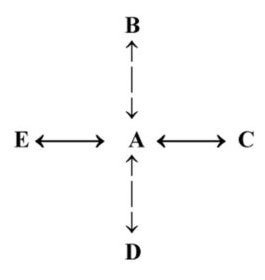
3) The Circle. Cf. collective collage, collective audio works, etc.
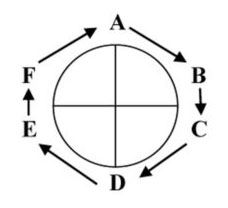
4) Combination (of 1), 2) or 3)). E.g. 2) and 2) (=Commonpress; Bambu; Care)
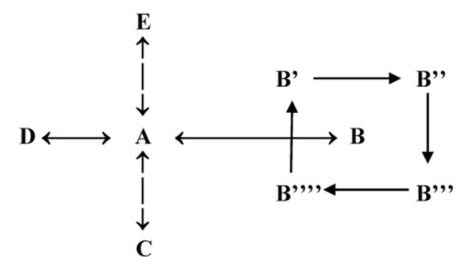
13. Philosophy
- “The” philosophy of Mail-Art does not exist. Every mail-artist has (the right to have) his “own” philosophy of Mail-Art. And in principle, every mail-artist has the right to disagree with the previous sentence.
- The term philosophy has different meanings. I don’t use it here as science of sciences, but to indicate some general meta-empirical reflections.
- Mail-Art is teamwork. Thinking about Mail-Art is thinking together.
- “Art is in its performance and direction dependent on the time, in which it lives, and the artists re creatures of their epoch” (Dadaistic Manifest, 1918). “(…) Therefore it is perhaps impossible to define ‘art in general’. There is always but an historic art, i.e. related to its technique, its ways of expression, its particularity of style (…)” (Georg Simmel, 1918). Mail-Art is not a ‘deus ex machina’ to save art or life. It is what it is and nothing more. Related to time, Mail-Art is an aesthetic-artistic and socio-cultural challenge, never found in other times: a global network of thousands of artists. It is the biggest art-movement that has ever been in the history of art. And it keeps on growing every day…
- Today time and space are experienced as relative concepts, especially through the evolution of technology. These experiences bring a new global consciousness. Our inner environment (space), being a miniature of the outer space, we find a planetary scope and vision in Mail-Art. It means cross-cultural and universal co-operation, a bridge over the traditional cultural cleavage between east – west, north – south. In its best shape, Mail-Art is ‘internationalism’, or better ‘transnationalism’!
- “The anarchy of taste” (Wilhelm Dilthey). “If someone calls it art, it’s art” (Don Judd). In the past art was “mythos”, science was “logos”. Today the art mythology has but one real art standard. The philosophy of art is the philosophy of money. Art has become a money-making machine.
- The philosophy of Mail-Art is a databank of all the ideas about it.
- Mail-Art presents no synthesis of art. Mail-Art is not the art of arts. But it opens a socio-cultural gate to think and operate in a synthetically direction. It offers no structured model of preceding art-techniques, art-movements, etc., but rather a collage and assemblage of them. Mail-Art is the laboratory and lavatory of the present art-labyrinth.
- Mail-Art causes a deflation of the primary artistic communication. The fresh roots of Mail-Art absorb their food in subterraneous traditions.
- The earth is the sculpture and canvas on which Mail-Artists operate. Optimism: in the far future the planets will take over these functions.
- We have learned to reject all kinds of information, if they do not correspond with our learned ways of thinking, feeling…
- The objects of Mail-Art are not so important after all. This has nothing to do with conceptual art or with Dadaism (in the sense of anti-art). Mail-Art is communication-art. It needs a new way of thinking. A lot of traditional artists who do not or will not understand this, quit sooner of later the Mail-Art network because of pure aesthetic quality-aspects of junk-mail objects. More significant than these Mail-Art products are the Mail-Art processes the experiences, activities, performances, and ritual actions. Neither the common results of these processes (which can be mental, e.g. memories, or material, e.g. a catalogue), nor the individual results (the Mail-Art objects) can give more than only an illustration of the real meaning of Mail-Art: the living communication. Maybe electronic (computerized, tele-communicated) mail will indicate the relativity of Mail-Art artifacts in a clearer way and better stress the meaning of the global cultural circuit and its communicative relationships.
- Tele-. Instant communication via telecommunication media will of course cause new Mail-Art problems of a immediacy. Perhaps it is the distance in time and space (via the post medium) that keeps Mail-Artists together. It gives them enough time to think to get certain emotions under control and to send less impulsive (read less aggressive, intolerant, competitive) reactions.
- Art or “the philosophy of stuttering”. In a certain way art repeats itself. “Art lives through influencing other art, not by existing as the physical residue of an artists’ ideas. The reason why different artists from the past are brought alive again is because some aspects of their work become useable by living artists” (Joseph Kosuth).
- Mail-Art archives are living cemeteries of memories and curiosities. The 42.292 Mail-Art administration mummifies all the received results of Mail-Art activities. It files the present art communication for posterity. ‘Indirect’ communication.
- We can say about Mail-Art what Friedrich Schiller said about religion. “Which religion do I believe in? None of those you have mentioned. And why not? That is my religion!”
- Consciousness. Mail-Art creates a new methodological consciousness of collaboration and co-participation, of crossing geographical boundaries and the mental borders of art, of crossing the frames of art objects.
- Human knowledge is colored, relative and limited. “It is not enough that people should know one another; they should know one another on terms of equal status” (Kurt Lewin). Mail-Artists are not equal, but equivalent (equal in value).
- Mail-Art aims the acceptance of being, thinking, feeling, acting, … differently! They co-existence of antithetical standpoints is possible.
- Our time is one of cocktails, mixture, ragout, eclecticism, interdisciplinarity, … In the same way Mail-Art is association, combination, an art-mixer and art-modulator.
- “Since wars begin in the minds of men, it is in the minds of men that the defenses of peace must be constructed…” (Preamble of the Constitution of the UNESCO). Mail-Art is / aims friendship, individualism, democracy, peace, diversification, brotherhood, pluralism, tolerance, co-operation, acculturation, freedom and liberation, decentralization, no leadership (horizontal instead of vertical communication), reciprocal relationships. If Mail-Art is dreaming, it is dreaming together.
- Only within the ‘frame of reference’ of a planetary connection a wider artistic and cultural context the phenomenon of Mail-Art can be really understood and interpreted.
- Art and its meanings. We are prisoners of our concepts (notions). Art as decoration. Art as art. Mail-Art as life, a map of the world, a universal language, an attitude to life, ‘a strategy of experiences’ (Laing), eco-centrism. “As far as Mail-Art serves life, we want to serve it!”
- In principle the traditional tautology of art: art = art (it is art or not) is rejected in Mail-Art. Mail-Art is art and Mail-Art is not art. This is not a contradiction, because it depends e.g. on circumstances, intentions, and context. There is an art level and a Mail-Art level. Art? Mail-Art!
- The game of traditional art does not allow to place the concepts of art and not-art, culture and nature in one specific model. Yet, Mail-Art does not change in the first place the artistic rules, but it is the democratizing the socio-cultural conditions to participate in the artistic field. Freedom in art means that one can choose his/her own aesthetic-cultural aims. Usually the Mail-Artist is not a “homo economicus”, but a “homo ludens” (Huizinga). Games and plays are the basis of all culture. In this sense Mail-Art has nothing to do with amateurism, Mail-Art is professionalism! It means cultural emancipation of repressive think tanks.
- “Worüber man nicht schweigen kann, davon muss man sprechen” (nach Ludwig Wittgenstein). Sending ‘no’ information is also sending information. But does it communicate? How much of our communication is based on misunderstanding?
- Sharing activity Mail-Art encourages dialogue, because the latter contains a maximum of reciprocity and communication.
- Mail-Art in terms of dialectics: the thesis understanding and the anti-thesis misunderstanding meet one another in the synthesis ‘Mail-Art dialogue’.
- Mutual communication. Zarathustra to the sun: “Du grosses gestirn! Was wäre dein Glück, wenn du nicht die hättest, welchen du leuchtest! Zehn Jahre kamst du hier herauf zu meiner Höhle: du würdest deines Lichtes und dieses Weges satt geworden sein, ohne mich, meinen Adler und meine Schlange” (Friedrich Nietzsche, 1883).
- Analogue thinking is sometimes confusing. Anyway. The Mail-Art Network is a real Open University (Universitas), Where artists learn and teach one another. The exchange and interchange art, information, passions and ideas. Mail-Art is a learning process via experiences, of trial and error in the wider process of artists’ communication. It is a new stimulus for art as a universal language. Mail-Art networking is togetherness and for thousands of artists and non-artists this planetary communication is a cultural and artistic alternative, without the pressure of one absolute model of art, reality or society. Mail-Art is an organic transnational plant, a Nettle with different offshoots and rootstocks. It is not a chain depending on the strength of each of its parts (members). Many first generation mail artists left the network but the plant keeps on growing…
- The future of Mail-Art. Every important art movement brings a new hypostasis. This hypostasis concerns a new form, or a least a technique or an idea to reach a certain form. (The foregoing does not mean that art is mere form, but that contents need form to exist). For instance, concept as hypostasis in conceptualism (a mental form is also a form); the artist in performance art; land or nature in land-art; anti-art in Dadaism; motion in kinetic-art; light in light-art; etc. So, every art movement has its limits. The transcendence of a limit creates a new limit. The hypostasis of Mail-Art is exchange or communication or correspondence. In case someone would say that Mail-Art has no philosophy, no content or no hypostasis, this would be its hypostasis! But it would be a lie to say that Mail-Art has no limits. When the ultimate object of an art movement is its own form or idea, it becomes dogmatic. Dogmatism means the end or art. So, the future of Mail-Art and art in general, is the transcendence of its own limits, i.e. its self-destruction. Or paraphrasing Friedrich Nietzsche “Mail-Art is something to be surpassed”. But Mail-Art is not an ordinary art movement or art form. It developed and is a new art circuit, a new medium. As long as this network stays healthy, Mail-Art has an independent future… Mail-Art is not only a form; it is a method. Mail-Art is on-the-road art, not near-the-road art; it is a process…
- Mail-Art becomes what it becomes and nothing more. But how to distinguish what Mail-Art is and wishes, what is and ought to? The proof of the pudding is in the eating not in the receipt.
- “The mark of our time is in its revulsion against imposed patterns. We are suddenly eager to have things and people declare their beings totally. There is a deep faith to be found in this new attitude – a faith that concerns the ultimate harmony of all being” (Marshall McLuhan, 1964).
- Mail-Art is a creative child of this new way of thinking. It tries to anticipate the cultural and artistic processes of communication in an electronic environment.
- Message of the exodus: one can always see it from another angle of view or experience it through another medium.
